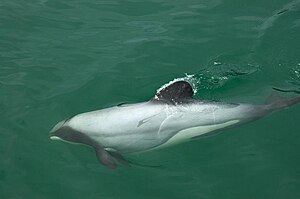Hector dolphin
| Hector dolphin | ||||||||||||
|---|---|---|---|---|---|---|---|---|---|---|---|---|

Hector's Dolphin ( Cephalorhynchus hectori ) |
||||||||||||
| Systematics | ||||||||||||
|
||||||||||||
| Scientific name | ||||||||||||
| Cephalorhynchus hectori | ||||||||||||
| ( P.-J. van Beneden , 1881) |
The Hector's dolphin ( Cephalorhynchus hectori ) is one of the smallest representatives of the dolphins with a length of up to 1.50 meters . It belongs to the genus of the black and white dolphins ( Cephalorhynchus ) and is only found in the waters around New Zealand .
features
The dolphin is a maximum of 1.50 meters long and weighs 40 to 60 kilograms. It has a very short, externally barely noticeable snout and a rounded dorsal fin . The flukes are pointed, their two rear edges are (negatively) rounded inward. The body of the animal is gray in the basic color, which is a drawing made up of different tones of the color. The forehead is drawn with black stripes and the muzzle is also black at its tip. The throat and neck are white. From the dark gray pectoral fins ( flippers ) to the eyes there is also a dark gray spot. The belly is white and a darker stripe runs down from the dorsal fin . The rest of the flanks are light gray.
At birth, the Hector dolphin weighs around 9 kilograms and has a life expectancy of around 20 years.
It is a sociable dolphin that lives together in groups of two to eight animals. They are very active and playful, riding waves and also playing with seaweed. During the frequent jumps, individual animals like to land on their side and create a loud and splashing gush of water.
distribution
The Hector's dolphin is found only in the waters around New Zealand. Two populations are known to be located east and west of the South Island. It is believed that these populations are separated from each other by the deeper areas of the Cook Strait and at the southwest end of the island. The animals do not cross these depths or only very rarely. Obviously, they are not much further than 10 kilometers from the coast.
The Maui dolphin ( Cephalorhynchus hectori maui ) lives on the west coast of the North Island of New Zealand , a subspecies with a total of probably only 100 individuals.
Threat and protection
The total population of dolphins was estimated at around 50,000 specimens in the early 1970s; in February 2017, according to a report in the journal Science , the population was only 10,000 individuals, and the Department of Conservation in New Zealand assumed 15,000 specimens in 2016. The main threat to the animals comes from the fishermen's nets, in which they can get caught and drown. In addition to industrial fishing, amateur fishermen are also a threat to the remaining Hector and Maui dolphins. Since there are tens of thousands of private gill nets, each up to 60 meters long, no one knows how many dolphins can get caught in them.
In 1988 an area of the coastal region of the Banks Peninsula was declared a protected area and fishing in the area was banned. Although this measure stopped the decline, an increase in the population has not yet been determined. In May 2004, the New Zealand Department of Conservation developed a whale tracking system and tested it on three of the Hector's dolphins. In the future, it will primarily be used to locate the extremely endangered animals off Maui.
Web links
- Cephalorhynchus hectori in the endangered Red List species the IUCN 2006. Posted by: Slooten & Taylor, 2000. Retrieved on 5 May, 2006.
Individual evidence
- ↑ a b c Hector's dolphin . Department of Conservation , accessed April 16, 2019 .
- ^ Christopher Pala : New Zealand's endemic dolphins are hanging by a thread . In: Science . Volume 355 , No. 6325 , 2017, p. 559 , doi : 10.1126 / science.355.6325.559 (English).
